Chester Osborn’s Cube turns five: ‘My father thought I was crazy’
Winemaker, artist and impresario Chester Osborn was told his “ridiculous” Cube concept would never get built. Now he’s about to celebrate five years of worldwide acclaim.

Lifestyle
Don't miss out on the headlines from Lifestyle. Followed categories will be added to My News.
When renowned winemaker Chester Osborn came up with the outlandish ideaof putting a towering modernist structure promoting wine and art on the sweeping hills around McLaren Vale, he was ready for the blowback. The man famous for the most colourful shirts in Australian wine and business knew he was challenging the status quo.
But even he was surprised that plans for what became the d’Arenberg Cube would take 11 years just to get past his own winery’s board.
“I had already built a model of the Cube and my father and his brother and sister took one look at it and thought it was ridiculous and that I was crazy,” Osborn says.
“They said it would never happen.
“My father is still coming to grips with it.
“He has always been conservative and doesn’t like to spend money on anything that isn’t seen as absolutely necessary.
“As for the board, they were a generally conservative group who saw this as a radical idea that was at odds with the whole history of the business, the old structures and the vineyards. There was no other building in McLaren Vale that needed a five-storey lift, it was just outlandish.
“They took a long time to come around.”
The resistance wasn’t just at board level, by any means.
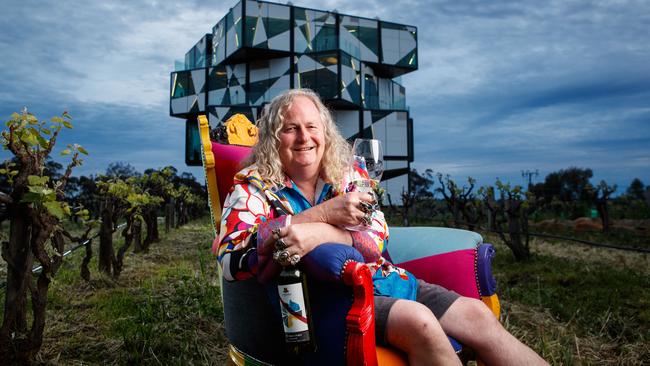
The idea of constructing a five-storey building that resembled an unsolved, unhinged Rubik’s cube was seen by many as a garish scar on the McLaren Vale landscape.
This wasn’t helped much by an unfortunate public event in 2015, when the concept generated widespread anger within the McLaren Vale and broader winemaking communities.
In the shadow of the Global Financial Crisis (GFC), which had hit the wine industry hard, d’Arenberg became the unwitting villain.
It came to a bit of a head when the then South Australian tourism minister Leon Bignall announced at a packed winemakers’ lunch that the state government was backing development of the d’Arenberg Cube to the tune of $2m.
“Well, the announcement went down like a lead balloon,” Osborn recalls.
“The wine industry was coming out of hard times and the government was giving money to this weird Cube idea.
“There were 700 or 800 people there and not one person came up to me and said congratulations; not even those people I still consider friends. It wasn’t a case of a few disgruntled murmurs, people were vocally and visually upset.
“And I do understand why they were upset.
“We were coming out of the GFC, d’Arenberg was a pretty successful company and here we were being handed this great sum of money.
“But all the people at that lunch heard were the words ‘two million dollars’ and by the time there was an announcement that we were going to employ 65 permanents on top of the construction jobs, people weren’t listening.
“It was supposed to be a one-for-three spend but obviously we put a lot more money into it.
“The government got their money back before we even opened the doors. Every year, they’ve got $2m worth of wages back.”
Still, go ahead it finally did and, while there are still plenty of critics, it has become a beacon for tourists and a striking signpost signifying the best of wine and art in the region.
Within months of its official launch in December 2017, the d’Arenberg Cube collected eight state and national design and tourism prizes including the Premier’s Award for Excellence at the 2018 State Tourism Awards.
It has now attracted more than a million visitors and made international headlines. Its image adorns the home page of southaustralia.com.In December, it celebrates its fifth anniversary.

The concept of the Cube was something of a Eureka moment after Osborn initially considered creating traditionally appealing extensions to the d’Arenberg homestead to meet a rapid growth in visitor interest.
He realised that any modern extensions to the 1895 dwellings would be historic in appearance only.
He reasoned that, if anything, building a reproduction would be disrespectful to the d’Arenberg history that went through many incarnations after the Osborn family bought the land on which the winery now stands in 1912.
A new creation, Osborn figured, was the only way to create a genuine, respectful addition.
“I’m not a good sleeper and I woke up one night and decided we needed something other than an old-style, fake homestead that pretended to be in line with 120 years of tradition,” Osborn recalls.
“I thought, if you had to model a new building, what’s the most iconic building in Australia? It’s the Sydney Opera House. It represents the sea, sailing and waves, everything relevant to its environment.
“So I wondered what sort of design would represent wine. Well, wine is such a puzzle to work out and labels are such a puzzle. So what’s the most iconic puzzle?
“I figured it was the Rubik’s cube. Then I thought, instead of putting colours on the outside, I’ll put puzzles on the outside to reflect the complexities of winemaking and make it even harder to work out.”
Osborn had many obstacles to clear before his vision could become a reality – the aforementioned opposition and, in 2008, the arrival of the GFC.
“In 2007, the wine industry was going along really well and we were exporting up to 80 per cent of our product and making very healthy margins so we bought an extra 200 acres (81ha), which increased our debt,” he says.
“Then the GFC hit. The industry turned around quite badly. We were making great wines that competed extremely well in the US but when the GFC hit, they turned on Australia for their own survival. That hurt considering America was a big part of my business.”
In the end, though, the setbacks and delays actually worked in Osborn’s favour and allowed for a better finished product.
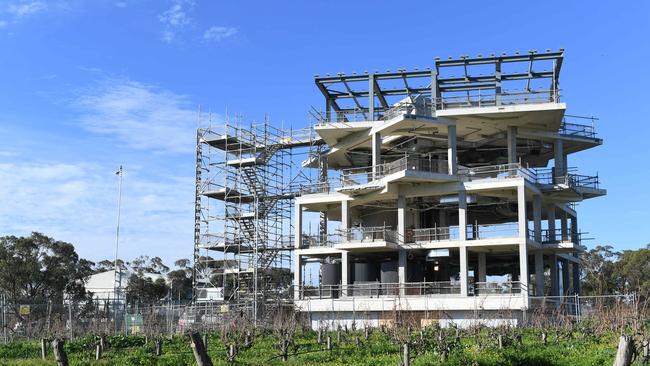
The double-tempered sheets of glass now recognised as essential to how the Cube was first imagined, did not even become available until just before construction began in 2015.
When it finally did – and 1350sq m of the double-tempered glass was needed for the many sides and roof – it set the Cube apart from any design of its type.
Once Osborn’s concept was drawn up by ADS Architects, the Cube took the team comprising Sarah Constructions, CPR Engineers and Construction Glazing almost three years to build. Two years was spent on the external construction and the best part of a year went into the internal fit-out that alone required one kilometre of LED lighting.
The 22m-high modernist construction was built for what is now considered a bargain-basement price of just $15m.
It stands beside the original homestead featuring d’Arry’s Verandah restaurant, an 1880s stable complex now used as a bottle shop and a marquee featuring pop up art exhibitions.
For all the hype over the striking external appearance of the curiously shaped edifice, the interior is every bit as fascinating.
It comprises a wine tasting room, virtual fermenter and a 360-degree video room, but the art museum and the seriously eclectic range of art installations are what sets the building apart from anything else within the Australian wine industry.
The world-class Pollyanna Restaurant, with international chef Jamie Steel returning after a stint overseas, has reopened as Singapore Circus on the third floor after its forced closure at the height of the Covid pandemic.
The Cube famously features 25 of Spanish surrealist Salvador Dali’s sculptures. Osborn explains that Dali decided to do a production run of 29 of his legendary sculptures in the 1970s and, after his death in 1989, the winemaker worked with the Dali family to secure samples for the Cube.
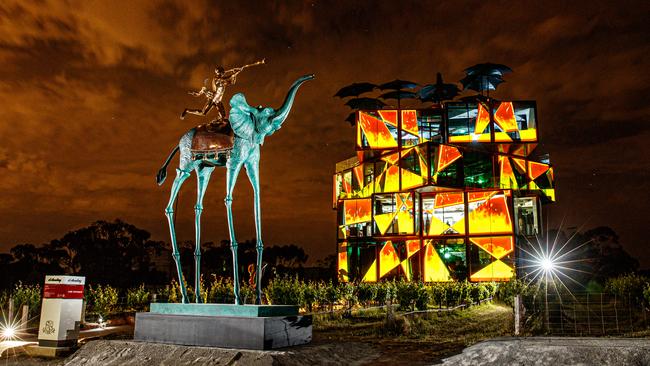
All Dali sculptors are on the market and the remaining 25 are available for serious art lovers with deep pockets.
The combination of the Dali artworks and Osborn’s own sculptures are backed up by the work on display of genuinely outstanding Australian artists. Renowned sculptors Ted Johnson and Greg Johns, Adelaide artist David Archer’s automata art and Charles Billich’s surrealist paintings are instrumental in ensuring the Cube is an art gallery, exhibition centre and outlet for high-end art as well as a wine centre, tasting room and world-class restaurant.
Massive Dali sculptures welcome visitors well before they reach the door, with Nobility of Time almost contradicting the urgency and excitement to be found within.
Osborn has placed more than 100 of his own artworks inside the structure. All of his art tells a story relating to the winery and winemaking, with each of the winemaker’s 76 labels represented. The sculptures are limited only by the artist and winemaker’s runaway imagination.
One sculpture, featuring a sheep in semi-human form as a nod to how often sheep are used at the vineyards, is nestled between vines preserved from 1880 and 1920.
Then there’s the sculpture filled with sand paying homage to the McLaren sand hills.
There’s the transparent head filled with thorns, barbs and burrs that reflects the battle against weeds in the vineyard.
There’s the bird sculpture representing the Feathered Dinosaur Cabernet based on the often overlooked fact that birds are the last living dinosaur.
There’s the ode to the Dead Arm Shiraz, featuring sculptures of skeletons, skulls and 19 arms. There’s the Pollyanna Polly sculpture filled with corks to represent the sparkling nature of the wine and finished with … what else? Crackers.
And there’s the sculpture of a giant crab holding on to two houses depicting d’Arenberg’s Hermit Crab label.
Confused? Visitors can download the app and listen to the explanation behind every art piece as they stroll through the multi-level art display. Every wine made by d’Arenberg gets a sculpture and they’re all explained.

The Cube is no one-trick pony that just captures the attention for a short time. Visitors often spend a whole day at the place, looking at static and interactive art for hours, going to wine blending classes, enjoying a world-class formal lunch, relaxing with coffee and cake, doing wine tastings and exploring the art installations inside and out.
“We want you here all day but, of course, people can spend a shorter time here and go off visiting other wineries or distilleries,” Osborn offers in a spirit of reciprocity.
“I’m just pleased that the Cube brings people to the region, where there are a hundred cellar doors. We’re only half an hour from the suburbs and people need to appreciate what the area offers in wine, tourism and dining.”

While art can rarely be measured in pragmatic or definitive terms, the success of the d’Arenberg Cube can turn to basic statistics to show its success. Before the Cube was constructed, the d’Arenberg winery attracted 40,000 to 50,000 visitors per year, a number Osborn hoped would swell to beyond 100,000 with the new structure.
The Cube pulled in 250,000 people per year before Covid hit – more than a 500 per cent increase in turnover and well over double what even the optimistic Osborn anticipated.
With the revamped restaurant and constantly changing attractions within the structure (SA Weekend’s food guru Simon Wilkinson gave the restaurant, Singapore Circus, a glowing review in last week’s pages), he expects those numbers to return over the next 12 months.
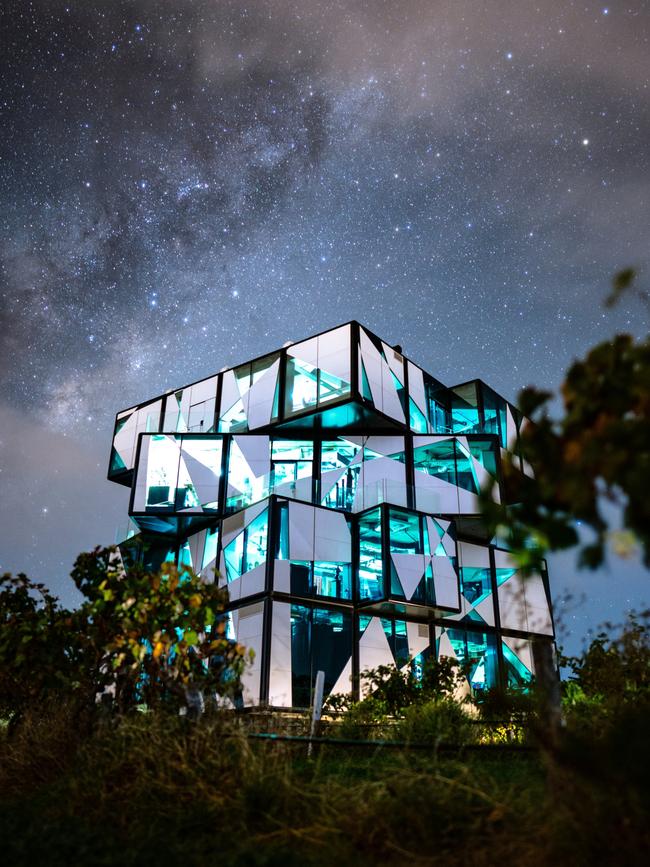
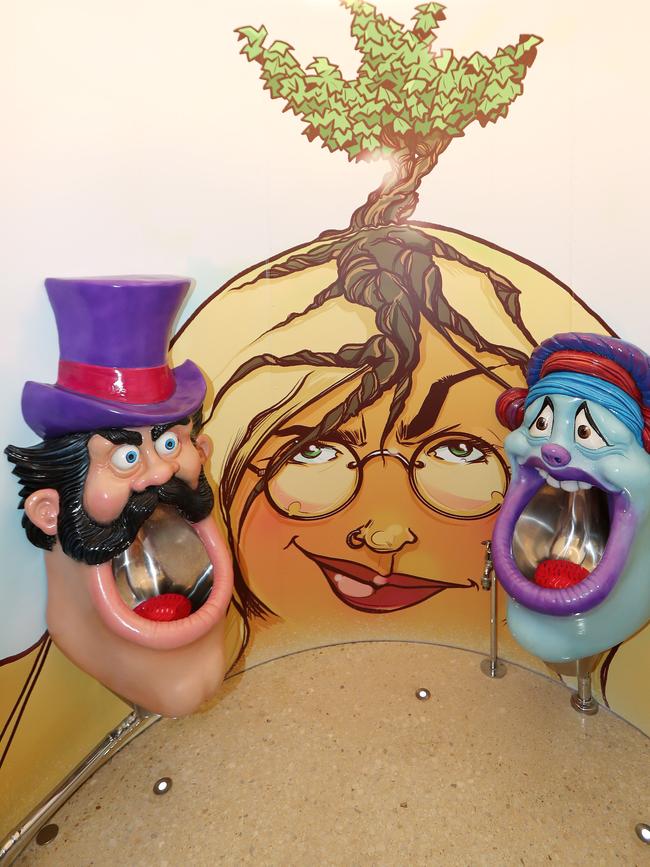
Just as Osborn is keen to see other McLaren Valewineries benefit from any increase in interest the Cube brings, the tourism bodies are equally thankful for his vision and work in promoting the region.
The South Australian Tourism Commission has been using images of the d’Arenberg Cube in its marketing campaigns since the place opened and it features prominently in the current campaign, A Little More.
Tourism Minister Zoe Bettison describes the Cube as “a prominent tourism drawcard” for the state, which is instrumental in attracting interstate and overseas visitors.
“With its iconic design, world-class food and wine, and a bevy of awards under its belt, the d’Arenberg Cube is a South Australian tourism hero and a must-see destination for visitors to our state,” the Minister says.
“It’s wonderful to celebrate five years of the d’Arenberg Cube and there’s no doubt it is one of our state’s many world-class operators which will help recover South Australia’s once $8.1bn visitor economy.”
McLaren Vale Grape Wine and Tourism Association chief executive Erin Leggat says the region owes a lot to “Chester’s unique vision and the development” of the d’Arenberg Cube.
“McLaren Vale and d’Arenberg Wines are inextricably entwined, and the recent growth in national and international focus on our region – particularly from a tourism and visitation perspective – owes a great deal to Chester’s vision,” she says.
“The Cube highlights the creativity, innovation and dynamism that our region is famous for – in our wines, in our restaurants and fresh produce, and in our unique visitor experiences.
“Its value-add to the regional visitor economy has been significant, providing a unique visitor experience and focal point for the region, and promoted extensively throughout Australia and the world as a Tourism Australia Ultimate Winery Experience and by SA Tourism.
“This has resulted in a significant increase in visitation numbers to the region prior to Covid-19, and has gone even further to put McLaren Vale on the map for international visitors.”
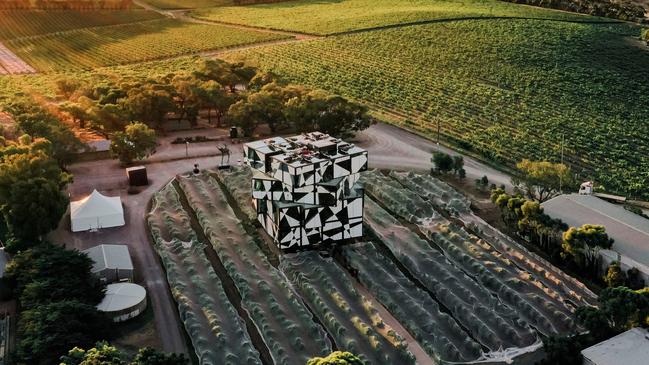
For all of Osborn’s unconventional – some would say eccentric – behaviour that helped create Australian wine’s most imposing tourist attraction, he is also one serious winemaker.
He grew up as a fourth generation member of a renowned wine family and went off as a young man to study viticulture at Roseworthy Agricultural College.
When he returned with a Bachelor of Applied Science in Oenology in 1983, he became deeply invested in taking d’Arenberg to new heights.
Always the entrepreneur, he recalls a chance meeting with expanding international wine exporter Rob McDonald at a Rundle Street tapas bar in the mid 1980s and convinced him to add d’Arenberg to his burgeoning list of labels.
It was the entry he needed to a growing US market, which has continued to import the McLaren Vale label.
Osborn understands the novelty appeal of the Cube, which people visit for an adventure and to see something completely different to anything else on cellar door tours around Australia.
Once they’ve arrived, though, he wants them to also appreciate the wine experience.
“We could have made soft, white wines with no structure to accommodate where the market went for a while but, instead, I kept making structured wines and that’s now become the new wave,” Osborn says with pride.
“People wanting bright, fragrant wines that will age for a long time is where we are. The d’Arenberg style really hasn’t changed that much, other than honing some wines in the quest for further improvement.
“We have so much to be thankful for, nestled where we are in the McLaren Vale.
“The sea has a big influence here. We get cooling sea breezes on hot summer days and we’re also in the rain shadow of the Adelaide Hills.
“It’s why McLaren Vale makes some of the greatest wines in the world.”
Today, d’Arenberg exports its wine to 80 countries around the world and has reclaimed the US market that faltered in the years immediately following the GFC.
It is recognised as one of the finest winemakers in a state that is world-renowned for its wines and its labels are sought after at the best restaurants here and abroad.
Chester Osborn’s one-time “ridiculous” idea to create a building every bit as flamboyant and outlandish as the shirts he wears, however, has done more than the finest wine could ever do.
It’s made sure people from all over the world have come to visit a breathtaking, imposing Cube that is equal parts winery, art gallery, restaurant and theme park.




